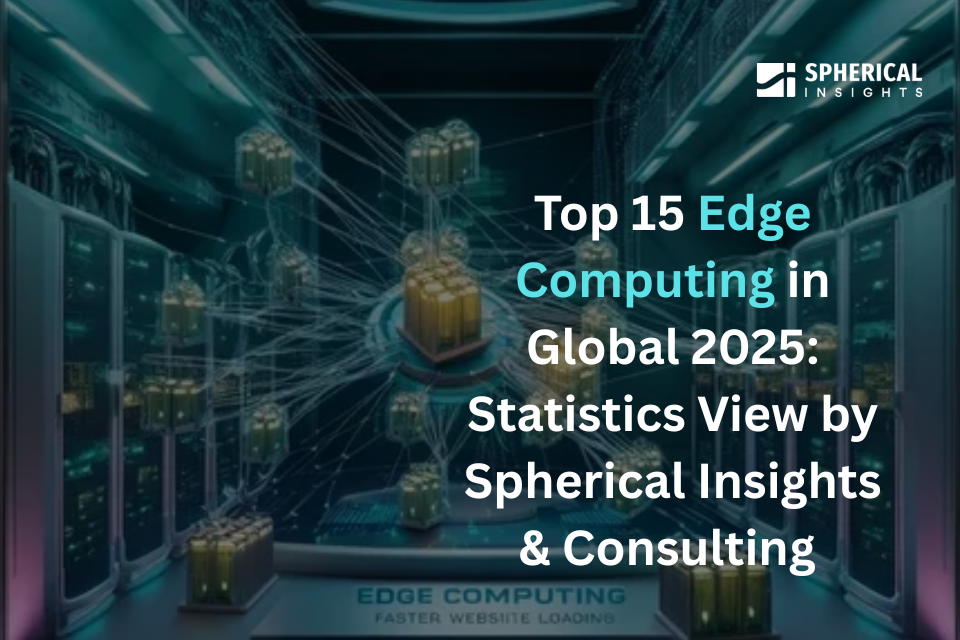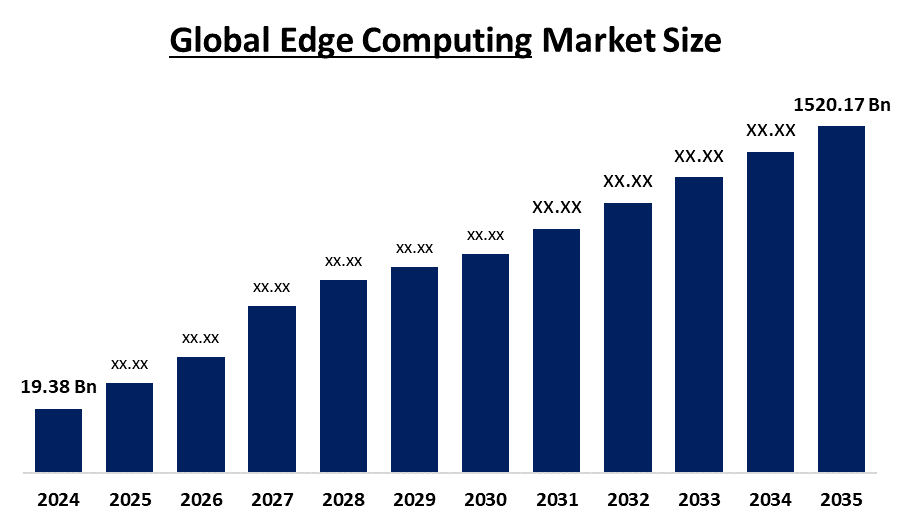
Top 15 Edge Computing in Global 2025: Statistics View by Spherical Insights & Consulting
RELEASE DATE: Jul 2025 Author: Spherical InsightsRequest Free Sample Speak to Analyst
Description
According to a research report published by Spherical Insights & Consulting, The Global Edge Computing Market Size is projected To Grow from USD 19.38 Billion in 2024 to USD 1520.17 Billion by 2035, at a CAGR of 48.67% during the forecast period 2025–2035. The market is driven by the deployment of 5G networks, which provide ultra-low latency, the quick growth of IoT devices, and the growing need for real-time data processing. To improve operational efficiency and lessen reliance on the cloud, industries such as manufacturing, healthcare, and automotive are implementing edge solutions.
Introduction
The global edge computing market refers to the industry centered on putting computing resources closer to data sources such as sensors, devices, and local servers instead of depending exclusively on centralized cloud infrastructure is known as the global edge computing market. Additionally, the market for edge computing is expanding as a result of these technologies' expansion. Instead of sending data to a central location for processing, edge computing processes data at the source. Edge computing offers the perfect infrastructure to manage the massive volumes of data generated by IoT devices, which must be processed instantly. On the other hand, SaaS applications need high reliability and low latency, which edge computing can offer. In the years to come, it is anticipated that the combination of edge computing and IoT and SaaS will spur market expansion and open up new business prospects.
Navigate Future Markets with Confidence: Insights from Spherical Insights LLP
The insights presented in this blog are derived from comprehensive market research conducted by Spherical Insights LLP, a trusted advisory partner to leading global enterprises. Backed by in-depth data analysis, expert forecasting, and industry-specific intelligence, our reports empower decision-makers to identify strategic growth opportunities in fast-evolving sectors. Clients seeking detailed market segmentation, competitive landscapes, regional outlooks, and future investment trends will find immense value in the full report. By leveraging our research, businesses can make informed decisions, gain a competitive edge, and stay ahead in the transition toward sustainable and profitable solutions.
Unlock exclusive market insights—now and dive deeper into the future of the Edge Computing Market.
Edge Computing Market Size & Statistics
The market for Edge Computing was estimated to be worth USD 19.38 Billion in 2024.
The market is going to expand at a CAGR of 48.67% between 2025 and 2035.
The Global Edge Computing Market is anticipated to reach USD 1520.17 Billion by 2035.
North America is expected to generate the highest demand during the forecast period in the Edge Computing market.
APAC is expected to grow the fastest during the forecast period in the Edge Computing market.

Regional growth and demand
APAC is expected to grow the fastest during the forecast period in the edge computing market. Deployments of 5G networks, which provide ultra-low latency and real-time data processing essential for edge applications are booming in the region. The need for localized computing is being driven by the significant investments made by nations like China, India, and Japan in smart manufacturing, industrial IoT, and smart city projects.
North America is expected to generate the highest demand during the forecast period in the wound care market. Since its extensive 5G deployment, sophisticated digital infrastructure, and high concentration of tech behemoths like IBM, Microsoft, and Amazon. The region's robust IoT device adoption and growing need for low-latency applications in industries like manufacturing, healthcare, and driverless cars are speeding up edge deployments.
Top 10 Wound Care Trends
- AI-Powered Wound Assessment
- Remote Monitoring via Edge Device
- Regenerative Medicine & Biologics
- Smart Dressings
- Advanced Antimicrobial Materials
- Negative Pressure Wound Therapy (NPWT)
- Decentralized Wound Care Platforms
- Integrated Wound Management Systems
- Personalized Wound Care Protocols
- Smart Hospital Integration
- AI-Powered Wound Assessment
AI-powered wound assessment avoids the delays of cloud-based processing by using edge-enabled imaging tools to analyze wounds instantly at the point of care. Real-time visual data, such as wound size, color, depth, and tissue composition, is captured and interpreted by these intelligent systems using algorithms that have been trained.
- Remote Monitoring via Edge Device
Remote monitoring eliminates the need for centralized cloud processing by enabling continuous wound data tracking at the patient's location through the use of edge-enabled wearables and sensors. Critical metrics such as temperature, moisture content, and healing progress are collected by these devices and sent locally via edge computing platforms for instantaneous analysis. While enabling patients to take care of their wounds at home, clinicians and caregivers can receive real-time alerts that prompt interventions in the event of complications.
- Regenerative Medicine & Biologics
Biologics and regenerative medicine, including stem cell treatments and growth factor dressings, provide cutting-edge approaches to wound healing by encouraging cellular repair and tissue regeneration. In order to maximize results, these treatments are becoming more and more individualized and depend on unique patient data. Because it allows for the real-time processing of clinical and biological data near the point of care, edge computing is essential to this process.
- Smart Dressings
A revolutionary advancement in wound care technology is represented by smart dressings with embedded sensors. By continuously monitoring vital wound parameters like temperature, pH balance, and moisture content, these intelligent materials provide vital information on the course of healing as well as possible side effects like infections. Clinicians can get real-time insights without depending on cloud infrastructure due to the local processing of this data made possible by integrating edge computing platforms.
- Advanced Antimicrobial Materials
In actively preventing and lowering the risk of infection, advanced antimicrobial materials—like medical-grade honey, silver-infused dressings, and bioactive compounds—are transforming wound care. These compounds produce conditions that promote healing and prevent bacterial growth, particularly in complicated and chronic wounds. By facilitating real-time analytics of treatment responses and microbial resistance patterns at the care site, edge computing increases their efficacy.
Empower your strategic planning:
Stay informed with the latest industry insights and market trends to identify new opportunities and drive growth in the wound care market. To explore more in-depth trends, insights, and forecasts, please refer to our detailed report.
Top 16 Companies Leading the Edge Computing Market
- Microsoft Corporation
- Google LLC
- IBM Corporation
- Intel Corporation
- Cisco Systems Inc.
- Hewlett Packard Enterprise (HPE)
- Dell Technologies
- NVIDIA Corporation
- Huawei Technologies Co. Ltd.
- Juniper Networks Inc.
- Advantech Co. Ltd.
- ADLINK Technology Inc.
- Schneider Electric SE
- Siemens AG
- Capgemini Engineering
- EdgeIQ (MachineShop Inc.)
- Microsoft Corporation
Headquarters - USA
Microsoft Corp. (Microsoft) develops and sells software, devices, and services. The company provides a wide range of products, including video games, desktop and server management tools, software development tools, business solution applications, server applications, cross-device productivity apps, and training and certification services. Additionally, it creates, produces, and markets hardware items such as PCs, tablets, gaming and entertainment consoles, and other smart gadgets.
- Google LLC
Headquarters – California, USA
Alphabet Inc.'s subsidiary Google LLC (Google) offers online search and advertising services. Advertising, search, platforms and operating systems, and hardware and enterprise products are among the company's business sectors. Google Search, Google Chrome, Google Calendar, Google Docs, Google Drive, Google Photos, Google Meet, Google Finance, Google News, Google Play Books, Google Earth, Google Ad Manager, Google Play, AdMob, Google Maps, AdSense, Gmail, Google Groups, and YouTube are among its offerings.
- IBM Corporation
Headquarters – Armonk, New York
International Business Machines Corporation is a global provider of integrated technology and services. Its Cognitive Solutions division sells Watson, a cognitive computing platform that can process large amounts of data, communicate in natural language, and learn from both human and computer interactions. Additionally, this segment provides analytics and data solutions, such as cloud data services, analytics and data management platforms, enterprise social software, talent management solutions, and industry-specific solutions; and transaction processing software that powers vital systems in the retail, banking, and airline sectors.
- Intel Corporation
Headquarters – Santa Clara, California, US
Technology components and products are designed and developed by Intel Corp. (Intel). Microprocessors, chipsets, embedded processors and microcontrollers, and Ethernet products are all part of the company's product line. Additionally, it provides technologies and solutions like cloud computing, data center solutions, robotics, 5G connectivity, artificial intelligence, and the internet of things. Core, Atom, Celeron, Pentium, Xeon, and Movidius are the brands under which Intel sells its processors. The business sells its goods and services to original equipment manufacturers, manufacturers of communications and industrial equipment, and manufacturers of original designs. Broadcasting, financial services, health and life sciences, government and public sectors, manufacturing, retail, education, industry, and transportation are among its clients. The
- Cisco Systems Inc.
Headquarters – San Jose, California, USA
The company offers a switching portfolio that includes campus and data center switching; an enterprise routing portfolio that connects public and private wireline and mobile networks, providing a highly secure and dependable connection to campus, data center, and branch networks; and wireless products that include indoor and outdoor wireless coverage for seamless roaming use of data, video, and voice applications.
Are you ready to discover more about the edge computing market?
The report provides an in-depth analysis of the leading companies operating in the global edge computing market. It includes a comparative assessment based on their product portfolios, business overviews, geographical footprint, strategic initiatives, market segment share, and SWOT analysis. Each company is profiled using a standardized format that includes:
Company Profiles
- Microsoft Corporation
- Business Overview
- Company Snapshot
- Products Overview
- Company Market Share Analysis
- Company Coverage Portfolio
- Financial Analysis
- Recent Developments
- Merger and Acquisitions
- SWOT Analysis
- Google LLC
- IBM Corporation
- Intel Corporation
- Cisco Systems Inc.
- Hewlett Packard Enterprise (HPE)
- Dell Technologies
- NVIDIA Corporation
- Huawei Technologies Co. Ltd.
- Juniper Networks Inc.
Conclusion
The global edge computing market is witnessing a dramatic shift as industries increasingly prioritize real-time data processing, low-latency applications, and decentralized infrastructure. Fueled by the rise of 5G networks and the proliferation of IoT devices, edge solutions are becoming essential in sectors like healthcare, manufacturing, and automotive. North America leads in demand due to its strong digital ecosystem, while Asia Pacific shows the fastest growth amid rising IT investments. Innovative applications in wound care such as smart dressings and AI-powered assessments highlight edge computing’s transformative potential in healthcare.
About the Spherical Insights & Consulting
Spherical Insights & Consulting is a market research and consulting firm which provides actionable market research study, quantitative forecasting and trends analysis provides forward-looking insight especially designed for decision makers and aids ROI.
Which is catering to different industry such as financial sectors, industrial sectors, government organizations, universities, non-profits and corporations. The company's mission is to work with businesses to achieve business objectives and maintain strategic improvements.
CONTACT US:
For More Information on Your Target Market, Please Contact Us Below:
Phone: +1 303 800 4326 (the U.S.)
Phone: +91 90289 24100 (APAC)
Email: inquiry@sphericalinsights.com, sales@sphericalinsights.com
Contact Us: https://www.sphericalinsights.com/contact-us
Need help to buy this report?